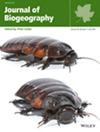Fire–climate–human dynamics over the last 1800 years in the mesic Araucaria-Nothofagus forests
Abstract
Aim
Few palaeoenvironmental studies have been performed in Araucaria-Nothofagus forests, which are highly vulnerable to ongoing threats from climate change and anthropogenic activities. The primary goal of this work is to reconstruct past environmental changes related to fire disturbances over the last 1800 years in Tolhuaca National Park (TNP), Chile.
Location
TNP, Araucanian region (38.2°S; 71.8°W), Northwestern Patagonia, Chile.
Taxa
Araucaria araucana (Araucariaceae), Nothofagus spp. (Nothofagaceae).
Methods
We completed charcoal and pollen analyses to create two new palaeoecological records that span 1800 years. We compared the lake-based reconstruction with the available local tree-ring fire scar chronologies from the last 430 years. Using these data, we compute forest index changes, biomass burning trends and compare with estimates of archaeological radiocarbon density. We place our inferences with context of published regional palaeoclimatic proxies from the Patagonian-Andean region.
Results
Our results showed that fire activity was higher than present between 200 and 1500 CE, with peaks around 200–400 CE and 1100–1500 CE. Periods with high fire activity are associated with reduced forest cover, as Araucaria declined when mixed-severity fire regime occurred for extended periods. Pollen assemblages suggested a shift from dry to wet climate conditions at 1500 CE, and from 1750 CE onward, the arrival of exotic species reflected the land-use changes related to forest clearance and transhumance practices.
Main Conclusions
The palaeoenvironmental reconstructions showed changes in vegetation, fire and climate over the past 1800 years in TNP. Wildfires have been the main disturbance process modifying the vegetation structure in the Araucaria and Nothofagus forests. Since 1750 CE intensive post-Hispanic land-use changes (forest clearances by fire and logging) took place in the study area, reducing the native vegetation cover. Climate variability, modulated by SAM-like and ENSO-like conditions, influenced the fire activity (availability and flammability of fuels), concomitantly with high archaeological density. The recent (after 2000 CE) increase of catastrophic wildfires may negatively affect the conservation strategies of Araucaria-Nothofagus forests.

 求助内容:
求助内容: 应助结果提醒方式:
应助结果提醒方式:


